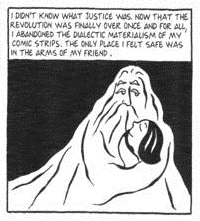Hello!
The start of October is upon us, and Halloween (along with many midterms) is coming up. This time, I am a class blogger.
Recently, my class has been going over the graphic narrative “Persepolis: The Story of a Childhood”, written and drawn by Marjane Satrapi. I enjoyed the book very much, and found myself completely engrossed in reading it.
The story it tells is incredibly eye-opening, giving readers a different perspective of what Iran is like. Following Marji, we find out what it was like to grow up during the Islamic Revolution of Iran, and its war with Iraq. Numerous times, I’ve found myself at a loss for words at the experiences that recounted in the book.

pg 70
For example, in page 70 of the book, we see Marji abandon her faith in God. As Isaiah points out, many people (at least, people in our privileged society and those not facing hardships such as war) do not look so critically upon their faith until they are much older than Marji had been. The depiction of this perfectly suits the way a child would behave when faced with the emotional stress of being helpless and finding an outlet for her frustration. It is also a very good depiction to how any person would act if they lost their belief in their religion. Anger, and frustration are very typical during such times, as well as the sense of bone-deep exhaustion because of the event or circumstance that has led them to questioning their faith.
 I especially love the panel immediately after Marji had cast God out of her life.
I especially love the panel immediately after Marji had cast God out of her life.
We see Marji seemingly floating in space, dark and nebulous. She is also very much alone. This shows Marji’s feelings of being at a loss of what to do. Having lost her faith, Marji has also lost one of her senses of support and safety in the universe, especially so shortly after her beloved uncle had been executed. It illustrates Marji’s bereavement fantastically.
With examples such as this, we can really see how each panel can be important towards the construction of the story.

pg 15
Ryan looks into the drawing style of “Persepolis”, and I agree with some of his thoughts. The black backgrounds fit the moods of certain scenes fairly well, leaving no room for doubt that the situation is ‘dark’. It’s dark in the way that it is tragic, it is sad, that it is a time where you question the good in humanity. Alternatively, the light/white backgrounds help lighten the book, often being used for happy or amusing situations. It makes it more lighthearted, and relieves the reader from the heaviness that usually accompanies those black backgrounds.

pg 106
As Ryan believes, Satrapi’s simplistic drawing style may be for the purpose of focusing a reader’s attention to the message she is trying to convey. However, I find myself thinking that maybe Satrapi’s drawing style, distinct in its simple and almost childish form, was to also demonstrate that this is from the perspective of a child.
Of course, I cannot say or know what Satrapi’s intentions were with using this particular art style, so I can only take the stance that this is my own thoughts about her work.
To end, I would like to point out that creators of graphic narratives draw with a purpose. Much like writers who carefully chose words to convey a message, the artists of graphic narratives carefully draw these images to convey a message as well. If there was no need to draw a particular object or action, than the artist would not have drawn it at all. Thus, while reading “Persepolis” (or any graphic narrative), I believe we should pay attention to what is drawn as much as we pay attention to what is written with words.
-Sandra



Sandra’s discussion of page 70 is extraordinarily fascinating as she touches on how Marji questions her religion at such a young age. If Marji were to have grown up in a country at peace, would she have been so closely connected to her faith at age ten? This brings up the discussion that young children growing up during heavily political events, such as the Iranian Revolution, are encouraged to mature into an adult and develop political opinions at a very young age. Marji, despite few immature tendencies, developed herself into a young adult devoted to her country by the age of ten. Naïvety and ignorance, often associated with childhood, seemed to be comprised for Marji as she matured during such an important time of her nation’s history.
-Erin Livinghouse